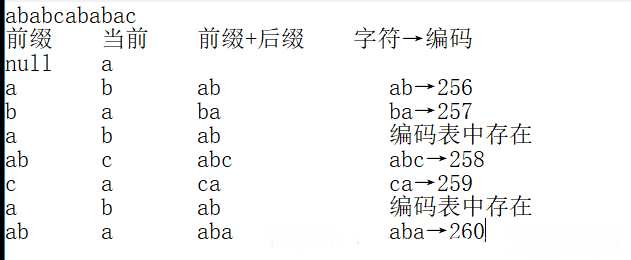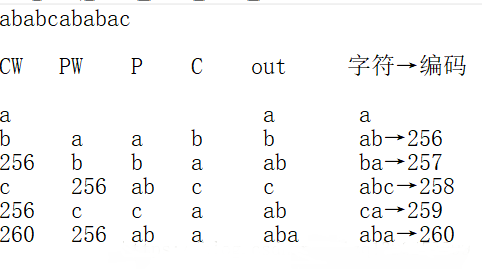жӮЁеҘҪпјҢзҷ»еҪ•еҗҺжүҚиғҪдёӢи®ўеҚ•е“ҰпјҒ
еҺӢзј©иҝҮзЁӢпјҡ
еүҚйқўе·Із»ҸеҶҷиҝҮдёҖзҜҮе“ҲеӨ«жӣјеҺӢзј©пјҢLZWеӯ—е…ёеҺӢзј©дёҺе“ҲеӨ«жӣјеҺӢзј©зҡ„дёҚеҗҢд№ӢеӨ„еңЁдәҺдёҚйңҖиҰҒжҠҠзј–з ҒеҶҷе…Ҙж–Ү件пјҢзј–з ҒиЎЁжҳҜеңЁиҜ»ж–Ү件дёӯз”ҹжҲҗзҡ„пјҢйҰ–е…Ҳе°Ҷ0-255дёӘASCLLз ҒдёҺеҜ№еә”зҡ„ж•°еӯ—еӯҳе…Ҙе“ҲеёҢиЎЁдёӯпјҢдҪңдёәеҹәзЎҖз ҒиЎЁгҖӮ

иҝҷйҮҢзҡ„еҗҺзјҖдёәеҪ“еүҚ
еүҚзјҖ+еҗҺзјҖ еҰӮжһңеңЁз ҒиЎЁдёӯеӯҳеңЁпјҢеүҚзјҖзӯүдәҺеүҚзјҖ+еҗҺзјҖгҖӮеҰӮжһңдёҚеӯҳеңЁпјҢе°ҶеүҚзјҖ+еҗҺзјҖжүҖиЎЁзӨәзҡ„еӯ—з¬ҰдёІеҶҷе…Ҙзј–з ҒиЎЁзј–з ҒпјҢеҗҢж—¶е°ҶеүҚзјҖеҶҷе…ҘеҺӢзј©ж–Ү件дёӯгҖӮиҝҷйҮҢйҮҚзӮ№жіЁж„ҸдёҖдёӢпјҢдёҖдёӘеӯ—иҠӮжүҖиғҪиЎЁзӨәзҡ„ж•°еӯ—иҢғеӣҙдёә0-255пјҢжүҖд»ҘжҲ‘们е°ҶдёҖдёӘеӯ—з¬Ұзҡ„зј–з ҒеҸҳжҲҗдёӨдёӘеӯ—иҠӮеҶҷиҝӣеҺ»пјҢеҲҶеҲ«еҶҷе…Ҙе®ғзҡ„й«ҳе…«дҪҚе’ҢдҪҺе…«дҪҚпјҢжҜ”еҰӮ256еҚідёә00000001 11111111 иҝҷйҮҢз”ЁеҲ°DataOutputStream dosеҜ№иұЎдёӯзҡ„ dos.writeChar(256)ж–№жі•гҖӮ
дёӨдёӘеӯ—иҠӮжүҖиғҪиЎЁзӨәзҡ„иҢғеӣҙдёә0-65535гҖӮеҪ“жҲ‘们зҡ„зј–з Ғи¶…иҝҮиҝҷд»ҪиҢғеӣҙпјҢе°ұйңҖиҰҒйҮҚзҪ®зј–з ҒиЎЁпјҢеҶҚйҮҚж–°зј–з ҒгҖӮ
и§ЈеҺӢиҝҮзЁӢ

CWиЎЁзӨәиҜ»еҸ–зҡ„еҲ°зҡ„еӯ—з¬ҰпјҢPWдёәдёҠдёҖиЎҢзҡ„CWпјҢCWеҶҚзј–з ҒиЎЁдёӯеӯҳеңЁпјҡPвҶ’PWпјҢCвҶ’CWзҡ„第дёҖдёӘеӯ—з¬ҰпјҢиҫ“еҮәCWгҖӮCWеңЁзј–з ҒиЎЁдёӯдёҚеӯҳеңЁпјҢPвҶ’PWпјҢCвҶ’PWзҡ„第дёҖеӯ—з¬Ұиҫ“еҮәP+CгҖӮ
еҪ“жҲ‘们иҜ»еҲ°65535зҡ„ж—¶еҖҷпјҢе°ұйҮҚзҪ®з ҒиЎЁпјҢйҮҚж–°зј–з ҒгҖӮ
д»Јз ҒйғЁеҲҶ
public class Yasuo {
private int bianma = 256;// зј–з Ғ
private String perfix = "";// еүҚзјҖ
private String suffix = "";// еҗҺзјҖ
private String zhongjian = "";// дёӯй—ҙеҸҳйҮҸ
HashMap<String, Integer> hm = new HashMap<String, Integer>();// зј–з ҒиЎЁ
private static String path = "D:\\JAVA\\еӯ—е…ёеҺӢзј©\\zidianyasuo.txt";// иҰҒеҺӢзј©зҡ„ж–Ү件
private static String path3 = "D:\\JAVA\\еӯ—е…ёеҺӢзј©\\yasuo.txt";// и§ЈеҺӢеҗҺзҡ„ж–Ү件
private static String path4 = "D:\\JAVA\\еӯ—е…ёеҺӢзј©\\jieya.txt";// и§ЈеҺӢеҗҺзҡ„ж–Ү件
public static void main(String[] args) throws IOException {
/**
* еҺӢзј©
*/
Yasuo yasuo = new Yasuo();
yasuo.yasuo();
/**
* и§ЈеҺӢ
*/
Jieya jie = new Jieya();
jie.jieya(path3,path4);
}
public void yasuo() throws IOException {
// еҲӣе»әж–Ү件иҫ“е…ҘжөҒ
InputStream is = new FileInputStream(path);
byte[] buffer = new byte[is.available()];// еҲӣе»әзј“еӯҳеҢәеҹҹ
is.read(buffer);// иҜ»е…ҘжүҖжңүзҡ„ж–Ү件еӯ—иҠӮ
String str = new String(buffer);// еҜ№еӯ—иҠӮиҝӣиЎҢеӨ„зҗҶ
is.close(); // е…ій—ӯжөҒ
// еҲӣе»әж–Ү件иҫ“еҮәжөҒ
OutputStream os = new FileOutputStream(path3);
DataOutputStream dos = new DataOutputStream(os);
// System.out.println(str);
// жҠҠжңҖеҹәжң¬зҡ„256дёӘAscllз Ғж”ҫзј–з ҒиЎЁдёӯ
for (int i = 0; i < 256; i++) {
char ch = (char) i;
String st = ch + "";
hm.put(st, i);
}
for (int i = 0; i < str.length(); i++) {
if(bianma==65535){
System.out.println("йҮҚзҪ®");
dos.writeChar(65535);//еҶҷеҮәдёҖдёӘ-1дҪңдёәйҮҚзҪ®зҡ„иЎЁзӨәдёҺз ҒиЎЁзҡ„жү“еҚ°
hm.clear();//жё…з©әHashmap
for (int j = 0; j < 256; j++) {//йҮҚж–°е°Ҷеҹәжң¬256дёӘзј–з ҒеҶҷе…Ҙ
char ch = (char) j;
String st = ch + "";
hm.put(st, j);
}
perfix="";
bianma=0;
}
char ch = str.charAt(i);
String s = ch + "";
suffix = s;
zhongjian = perfix + suffix;
if (hm.get(zhongjian) == null) {// еҰӮжһңз ҒиЎЁдёӯжІЎжңү еүҚзјҖеҠ еҗҺзјҖзҡ„з ҒиЎЁ
// System.out.print(zhongjian);
// System.out.println(" еҜ№еә”зҡ„зј–з Ғдёә " + bianma);
hm.put(zhongjian, bianma);// еҗ‘з ҒиЎЁж·»еҠ еүҚзјҖеҠ еҗҺзјҖ е’Ң еҜ№еә”зҡ„зј–з Ғ
// System.out.println(" " + perfix);
// System.out.println("еҶҷе…Ҙзҡ„зј–з Ғ "+hm.get(perfix));
dos.writeChar(hm.get(perfix)); // жҠҠеүҚзјҖеҶҷе…ҘеҺӢзј©ж–Ү件
bianma++;
perfix = suffix;
} else {// еҰӮжһңжңүдёӢдёҖдёӘеүҚзјҖдҝқеӯҳ дёҠдёҖдёӘеүҚзјҖеҠ еҗҺзјҖ
perfix = zhongjian;
}
if (i == str.length() - 1) {// жҠҠжңҖеҗҺдёҖдёӘеҶҷиҝӣеҺ»
// System.out.print("еҶҷе…ҘжңҖеҗҺдёҖдёӘ"+perfix);
dos.writeChar(hm.get(perfix));
// System.out.println(" "+hm.get(perfix));
}
}
os.close();// е…ій—ӯжөҒ
// System.out.println(hm.toString());// иҫ“еҮәз ҒиЎЁ
}
}
public class Jieya {
private ArrayList<Integer> list = new ArrayList<Integer>();// еӯҳй«ҳе…«дҪҚ
private int count = 0;// дёӢж Ү
private ArrayList<Integer> numlist = new ArrayList<>();// еӯҳзј–з Ғ
HashMap<String, Integer> hm = new HashMap<>();// зј–з ҒиЎЁ
HashMap<Integer, String> hm1 = new HashMap<>();// зј–з ҒиЎЁ
private String cw = "";
private String pw = "";
private String p = "";
private String c = "";
private int bianma = 256;
public void jieya(String path, String path2) throws IOException {
// иҜ»еҸ–еҺӢзј©ж–Ү件
InputStream is = new FileInputStream(path);
byte[] buffer = new byte[is.available()];
is.read(buffer);
is.close();// е…ій—ӯжөҒ
String str = new String(buffer);
// System.out.println(str);
// иҜ»й«ҳе…«дҪҚ жҠҠй«ҳе…«дҪҚжүҖиЎЁзӨәзҡ„ж•°еӯ—ж”ҫе…ҘListдёӯ
for (int i = 0; i < buffer.length; i += 2) {
int a = buffer[i];
list.add(a);// й«ҳе…«дҪҚеӯҳе…ҘlistеҲ—иЎЁдёӯ
}
for (int i = 1; i < buffer.length; i += 2) {// иҜ»дҪҺе…«дҪҚ
// System.out.println(list.get(count)+"---");
if (buffer[i] == -1 && buffer[i - 1] == -1) {
numlist.add(65535);
} else {
// System.out.println(i);
if (list.get(count) > 0) {// еҰӮжһңдҪҺе…«дҪҚеҜ№еә”зҡ„й«ҳе…«дҪҚдёә1
if (buffer[i] < 0) {
int a = buffer[i] + 256 + 256 * list.get(count);
// buffer[i]+=256+256*list.get(count);
numlist.add(a);// еӯҳе…Ҙnumlistдёӯ
} else {
int a = buffer[i] + 256 * (list.get(count));
// System.out.println(buffer[i]+" "+a + "+++");
numlist.add(a);// еӯҳе…Ҙnumlistдёӯ
}
} else {// й«ҳе…«дҪҚдёә0
// System.out.println(buffer[i]);
numlist.add((int) buffer[i]);// еӯҳе…Ҙnumlistдёӯ
}
count++;
}
}
// System.out.println(list.size()+" "+count+" "+numlist.size()+"жҜ”иҫғеӨ§е°Ҹ"+"
// "+buffer.length);
// for(int i=0;i<numlist.size();i++){
// System.out.println(numlist.get(i)+"p");
// }
/**
* жҠҠ0-255дҪҚеӯ—з¬Ұзј–з Ғ
*/
for (int i = 0; i < 256; i++) {
char ch = (char) i;
String st = ch + "";
hm.put(st, i);
hm1.put(i, st);
}
/**
* ж №жҚ®numlistйҳҹеҲ—дёӯзҡ„е…ғзҙ ејҖе§ӢйҮҚж–°зј–з ҒпјҢиҫ“еҮәж–Ү件
*/
// еҲӣе»әиҫ“еҮәжөҒ
OutputStream os = new FileOutputStream(path2);
// йҒҚеҺҶnumlist
for (int i = 0; i < numlist.size(); i++) {
int n = numlist.get(i);
if (hm.containsValue(n) == true) {// еҰӮжһңзј–з ҒиЎЁдёӯеӯҳеңЁ
cw = hm1.get(n);
// System.out.println(cw+"*");
if (pw != "") {
os.write(cw.getBytes("gbk"));
p = pw;
c = cw.charAt(0) + "";// c=cwзҡ„第дёҖдёӘ
// System.out.println(c+"&");
hm.put(p + c, bianma);
hm1.put(bianma, p + c);
bianma++;
} else {
os.write(cw.getBytes("gbk"));// 第дёҖдёӘ
}
} else {// зј–з ҒиЎЁдёӯдёҚеӯҳеңЁ
p = pw;
// System.out.println(pw+"-=");
c = pw.charAt(0) + "";// c=pwзҡ„第дёҖдёӘ
hm.put(p + c, bianma);
hm1.put(bianma, p + c);
bianma++;
os.write((p + c).getBytes("gbk"));
cw = p + c;
}
pw = cw;
// System.out.println(bianma);
// System.out.println(cw+"==");
if (i == 65535) {
System.out.println("йҮҚзҪ®2");
hm.clear();
hm1.clear();
for (int j = 0; j < 256; j++) {
char ch = (char) j;
String st = ch + "";
hm.put(st, j);
hm1.put(j, st);
}
bianma = 0;
pw = "";
}
}
// System.out.println(hm1.toString());
os.close();
}
}
дёҚи¶ід№ӢеӨ„пјҡеҪ“зј–з Ғи¶…иҝҮ65535зҡ„ж—¶еҖҷпјҢ并没жңүеӨ„зҗҶеҘҪпјҢдёҚиғҪйҮҚзҪ®з ҒиЎЁпјҢиҝҳеҺҹеҮәзҡ„ж–Ү件еңЁи¶…иҝҮ65535зҡ„йғЁеҲҶе°ұејҖе§Ӣд№ұз ҒгҖӮиҝҳжңүеҫ…ж”№е–„гҖӮ
жҖ»з»“
д»ҘдёҠе°ұжҳҜиҝҷзҜҮж–Үз« зҡ„е…ЁйғЁеҶ…е®№дәҶпјҢеёҢжңӣжң¬ж–Үзҡ„еҶ…е®№еҜ№еӨ§е®¶зҡ„еӯҰд№ жҲ–иҖ…е·ҘдҪңе…·жңүдёҖе®ҡзҡ„еҸӮиҖғеӯҰд№ д»·еҖјпјҢи°ўи°ўеӨ§е®¶еҜ№дәҝйҖҹдә‘зҡ„ж”ҜжҢҒгҖӮеҰӮжһңдҪ жғідәҶи§ЈжӣҙеӨҡзӣёе…іеҶ…е®№иҜ·жҹҘзңӢдёӢйқўзӣёе…ій“ҫжҺҘ
е…ҚиҙЈеЈ°жҳҺпјҡжң¬з«ҷеҸ‘еёғзҡ„еҶ…е®№пјҲеӣҫзүҮгҖҒи§Ҷйў‘е’Ңж–Үеӯ—пјүд»ҘеҺҹеҲӣгҖҒиҪ¬иҪҪе’ҢеҲҶдә«дёәдё»пјҢж–Үз« и§ӮзӮ№дёҚд»ЈиЎЁжң¬зҪ‘з«ҷз«ӢеңәпјҢеҰӮжһңж¶үеҸҠдҫөжқғиҜ·иҒ”зі»з«ҷй•ҝйӮ®з®ұпјҡis@yisu.comиҝӣиЎҢдёҫжҠҘпјҢ并жҸҗдҫӣзӣёе…іиҜҒжҚ®пјҢдёҖз»ҸжҹҘе®һпјҢе°Ҷз«ӢеҲ»еҲ йҷӨж¶үе«ҢдҫөжқғеҶ…е®№гҖӮ
жӮЁеҘҪпјҢзҷ»еҪ•еҗҺжүҚиғҪдёӢи®ўеҚ•е“ҰпјҒ